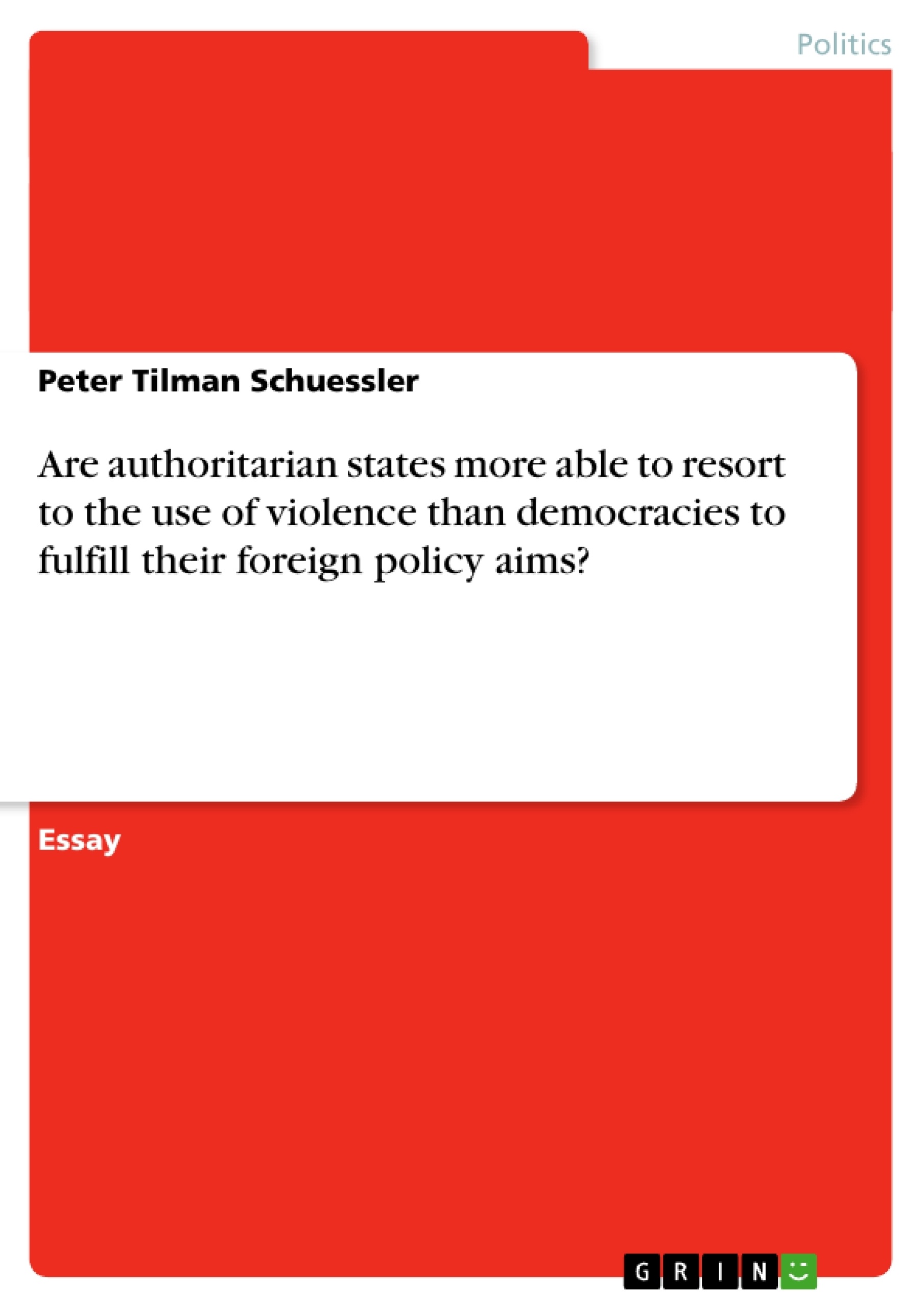To begin it is necessary to clarify the title of this essay. As the question treats foreign policy aims, violence in this context is to be seen as the use of coercive means outside the own state′s territory. This essay will furthermore not differentiate between the different authoritarian states and hence will include all non-democracies in this context. It will be therefore deal only with the capability and not with the probability of states to use violence.
The democratic structure and culture in general makes it harder for the elected governments to act violently but this paper will illustrate that dictatorships will also face some constraints. It will be shown in particular that it is more difficult for democracies to initiate aggressive military operations openly than for authoritarian states, but that there are few differences in the ability to respond to provocations or hostile actions. There are even less distinctions between both kinds of rule in certain "types of violence" like the deployment of covert actions
To demonstrate those contrarieties and similarities this text will deal firstly with implications of structure, public opinion, alliances, economy, etc. on the visible use of force and secondly compare the systems in regard to hidden operations. Hence there are so many different kinds of states that it is not possible to find suitable abstract descriptions of their capabilities. This essay will try to clarify the argument with some examples, well aware that they do not fit for all democratic and all authoritarian states.
Inhaltsverzeichnis (Table of Contents)
- Are authoritarian states more able to resort to the use of violence than democracies to fulfill their foreign policy aims?
- Comparing the structure of the governmental institutions and their interlinkages
- The population
- Political alliances and economic factors
- A good army
- The question now, do democracies or autocracies have better possibilities to pursue their foreign policy aims by clandestine operations?
Zielsetzung und Themenschwerpunkte (Objectives and Key Themes)
This essay examines the question of whether authoritarian states are more capable of using violence to achieve their foreign policy objectives than democracies. It focuses on the ability, rather than the likelihood, of states to utilize violence, considering both overt military actions and covert operations.
- The influence of governmental structures, public opinion, and alliances on the use of force
- The role of economic factors and military capabilities in achieving foreign policy goals
- The effectiveness of covert operations in achieving foreign policy objectives
- The potential for both democracies and authoritarian states to use violence in foreign policy
- The constraints and advantages faced by different types of states in using violence
Zusammenfassung der Kapitel (Chapter Summaries)
- The essay begins by clarifying the scope of the discussion, focusing on the use of coercive means outside a state's own territory. It further clarifies that the analysis will not differentiate between types of authoritarian states, but will encompass all non-democracies.
- The essay then explores the structural differences between democratic and authoritarian states, highlighting the checks and balances inherent in democracies that can make it more challenging to initiate aggressive military operations. The essay notes that while democratic leaders need to mobilize public opinion for support, authoritarian leaders face the threat of coups or revolts if they do not effectively repress opposition.
- The essay then examines the role of public opinion in shaping foreign policy. It argues that democratic leaders are more constrained by public opinion than authoritarian leaders, particularly when initiating attacks without clear justification. However, democratic leaders often find it easier to gain public support for retaliatory actions.
- The essay further explores the impact of political alliances and economic factors on the ability to use force. It highlights the democratic peace theory, which posits that democracies are less likely to engage in conflict with each other due to shared values and economic interdependence. Authoritarian states, while often having strong alliances, lack the shared moral values and economic ties that characterize democratic partnerships.
- The essay considers the role of military capability in achieving foreign policy objectives. It emphasizes the need for financial resources and advanced military knowledge to effectively deploy armed forces. While authoritarian states may have access to large sums of money, they often lack the scientific and educational resources needed to utilize sophisticated weaponry.
Schlüsselwörter (Keywords)
This essay focuses on the use of violence in international relations, comparing the capabilities of democratic and authoritarian states to achieve their foreign policy goals. Key themes include the influence of governmental structures, public opinion, alliances, and economic factors on the ability to use force, as well as the effectiveness of covert operations. The essay also explores the role of military capabilities, including financial resources and military knowledge, in achieving foreign policy objectives.
- Quote paper
- Peter Tilman Schuessler (Author), 2002, Are authoritarian states more able to resort to the use of violence than democracies to fulfill their foreign policy aims?, Munich, GRIN Verlag, https://www.grin.com/document/8908



